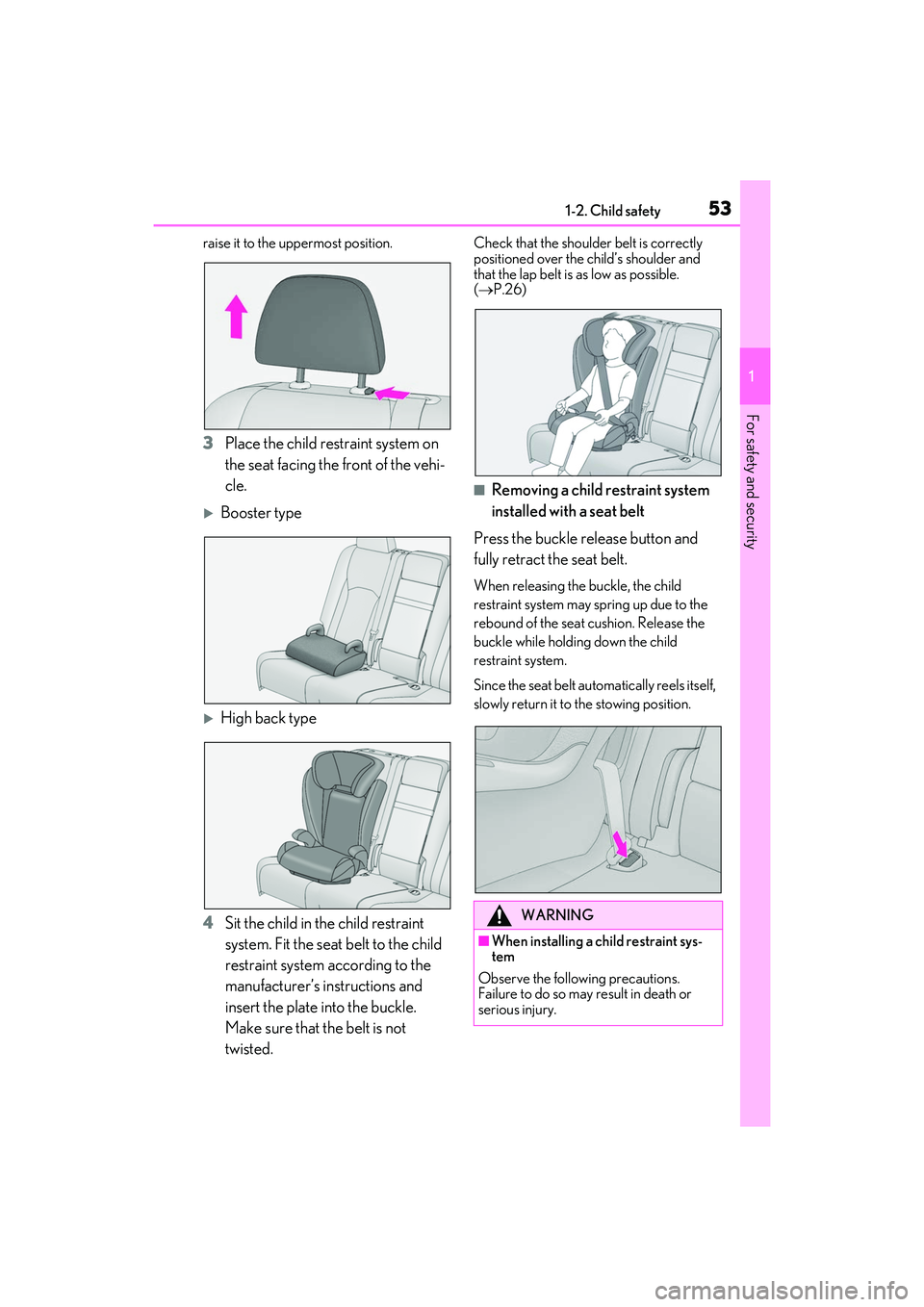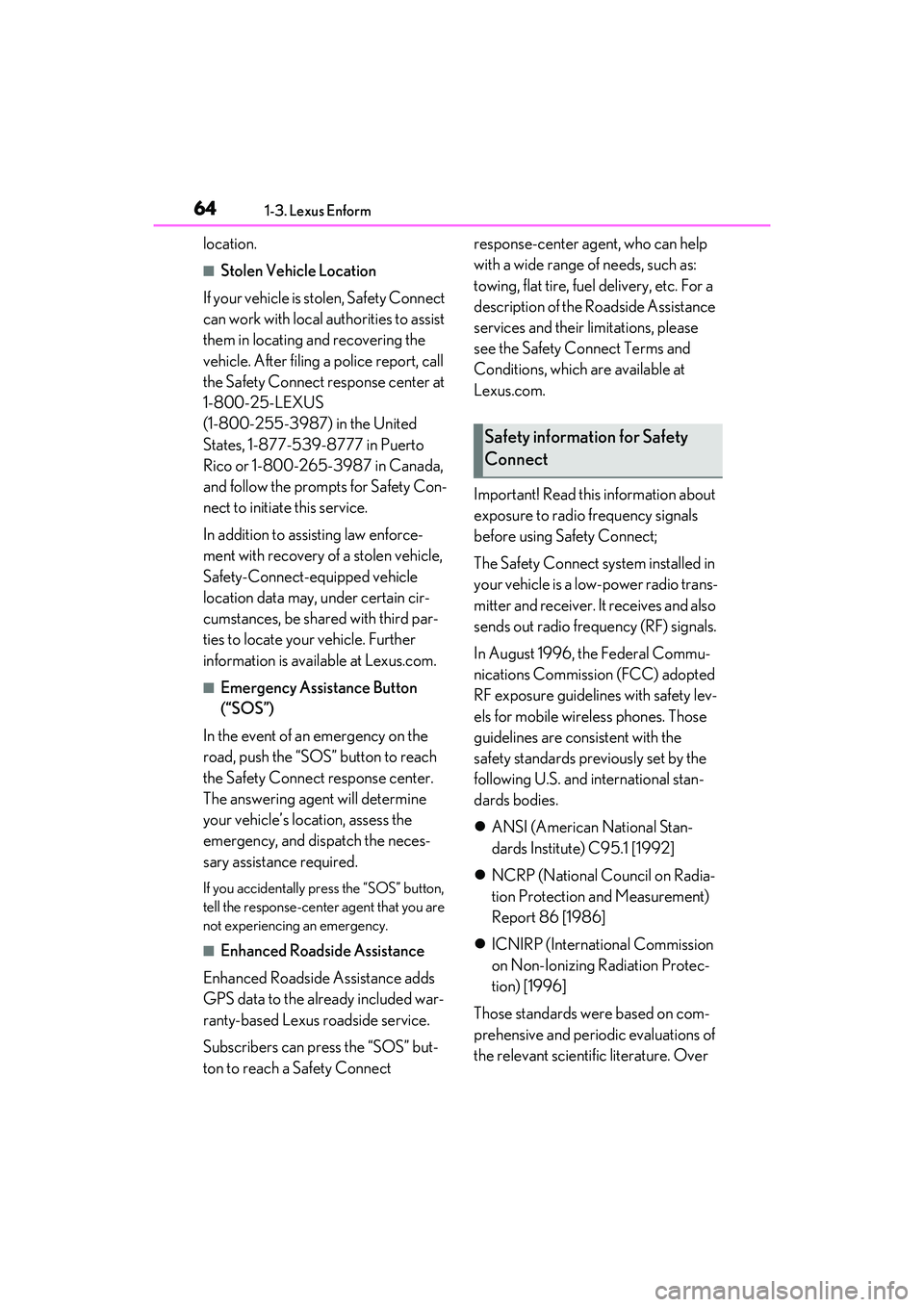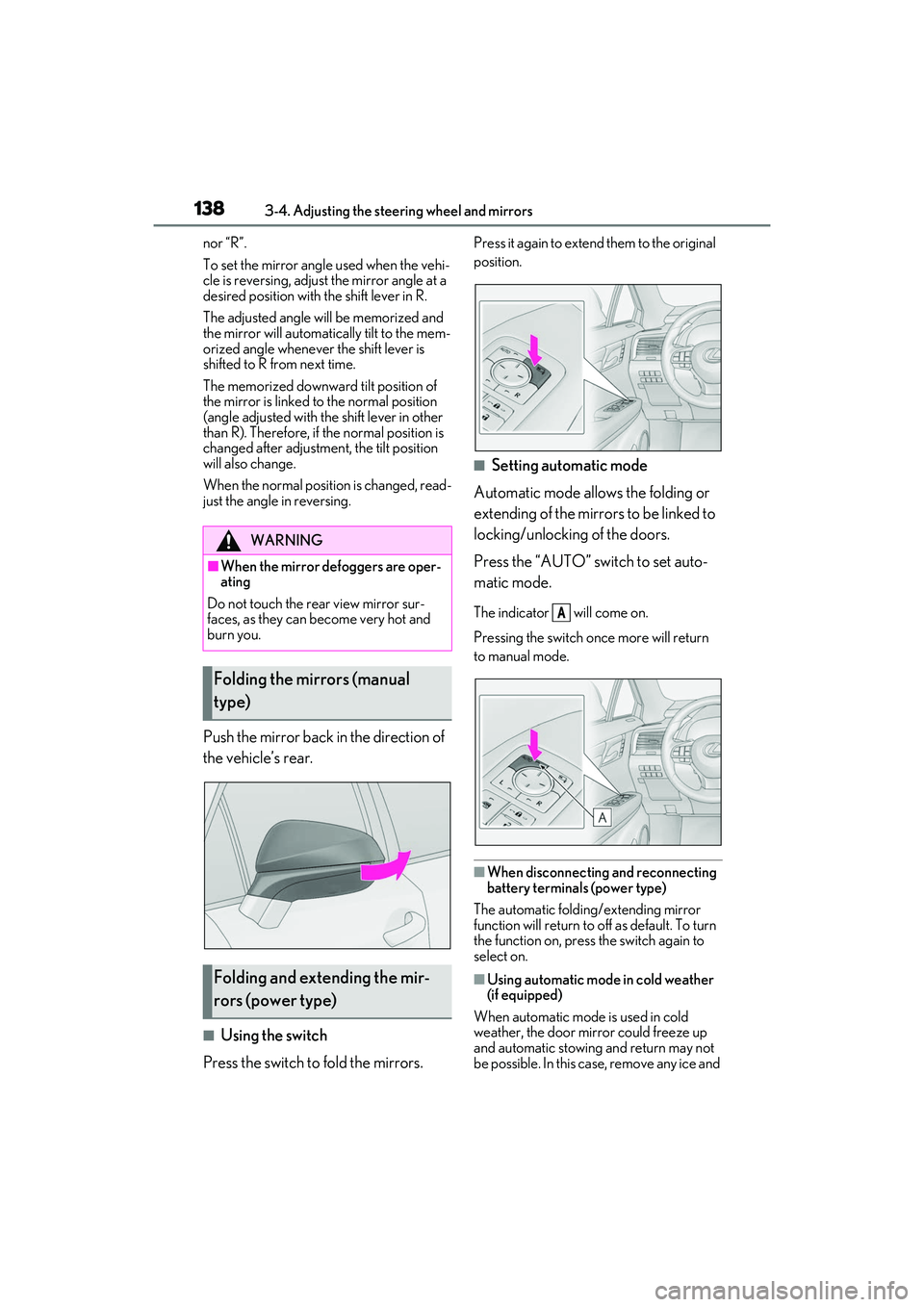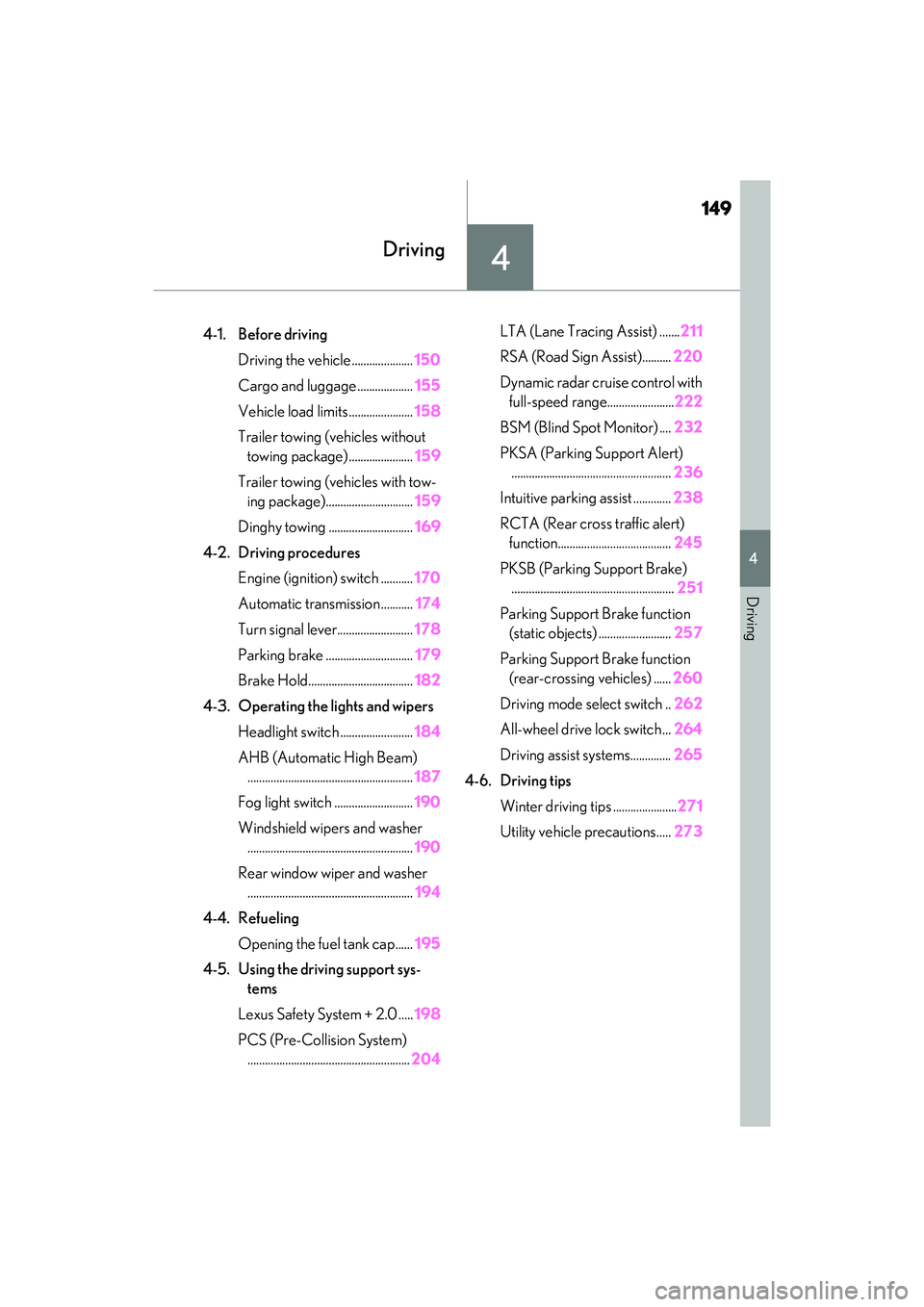2022 LEXUS RX350 towing
[x] Cancel search: towingPage 4 of 508

2TABLE OF CONTENTS
For your information ......................................6
Reading this manual .................................... 10
How to search ................................................. 11
Pictorial index ................................................. 12
1-1. For safe use Before driving .................................... 24
For safe driving.................................. 25
Seat belts ............................................. 26
SRS airbags ....................................... 30
Front passenger occupant classifi- cation system ................................. 39
Exhaust gas precautions .............. 44
1-2. Child safety Riding with children........................ 45
Child restraint systems ................. 45
1-3. Lexus Enform Lexus Enform Safety Connect .. 60
1-4. Theft deterrent system Engine immobili zer system .........66
Alarm.................................................... 67
2-1. Instrument cluster Warning lights and indicators .... 70
Gauges and meters ....................... 75
Multi-information display............. 79
Head-up display .............................. 86
Fuel consumption information ... 903-1. Key information
Keys ....................................................... 94
3-2. Opening, closing and locking the doors
Side doors ........................................... 97
Power back door ........................... 101
Smart access system with push-but- ton start ............................................ 113
3-3. Adjusting the seats Front seats.......................................... 117
Rear seats.......................................... 118
Driving position memory ............ 129
Head restraints ............................... 132
3-4. Adjusting the steering wheel and mirrors
Steering wheel ............................... 135
Inside rear view mirror ............... 136
Outside rear view mirrors.......... 137
3-5. Opening, closing the windows and moon roof
Power windows ............................. 140
Moon roof ......................................... 142
Panoramic moon roof ................. 145
4-1. Before driving Driving the vehicle........................ 150
Cargo and luggage...................... 155
Vehicle load limits......................... 158
Trailer towing (vehicles without towing package)......................... 159
1For safety and security
2Vehicle status information and
indicators
3Before driving
4Driving
Page 5 of 508

3TABLE OF CONTENTS
1
2
3
4
5
6
7
8
9
Trailer towing (vehicles with towing package) ........................................ 159
Dinghy towing ................................ 169
4-2. Driving procedures Engine (ignition) switch .............. 170
Automatic transmission.............. 174
Turn signal lever............................. 178
Parking brake ................................. 179
Brake Hold....................................... 182
4-3. Operating the lights and wipers Headlight switch ............................ 184
AHB (Automatic High Beam) ............................................................ 187
Fog light switch .............................. 190
Windshield wipers and washer ............................................................ 190
Rear window wiper and washer ............................................................ 194
4-4. Refueling Opening the fuel tank cap......... 195
4-5. Using the driving support systems Lexus Safety System + 2.0 ........ 198
PCS (Pre-Collision System).... 204
LTA (Lane Tracing Assist).......... 211
RSA (Road Sign Assist) ............. 220
Dynamic radar crui se control with
full-speed range ......................... 222
BSM (Blind Spot Monitor) ....... 232
PKSA (Parking Support Alert) ........................................................... 236
Intuitive parking assist ................ 238
RCTA (Rear cross traffic alert) function .......................................... 245
PKSB (Parking Support Brake) ............................................................ 251Parking Support Brake function
(static objects) ............................ 257
Parking Support Brake function (rear-crossing vehicles) ......... 260
Driving mode select switch ...... 262
All-wheel drive lock switch......264
Driving assist systems ................ 265
4-6. Driving tips Winter driving tips ......................... 271
Utility vehicle precautions........ 273
5-1. Remote Touch/Display Remote Touch............................... 278
Center Display.............................. 280
5-2. Lexus Climate Concierge Lexus Climate Concierge........ 283
5-3. Using the air conditioning system and defogger
Front automatic air conditioning system ............................................ 284
Rear automatic air conditioning system ............................................ 294
Heated steering wheel/seat heat- ers/seat ventilators................... 297
5-4. Using the interior lights Interior lights list ........................... 300
5-5. Using the storage features List of storag e features .............. 303
Luggage compartment features .......................................................... 309
5-6. Using the other interior features Other interior features ................ 314
Garage door opener ................. 326
Compass .......................................... 331
5Interior features
Page 16 of 508

14Pictorial index
■Instrument panel
Engine switch ........................................................................................................... P.170
Starting the engine/changing the modes ................................................................ P.170
Emergency stop of the engine ....................................................................................P.384
When the engine will not start...................................................................................... P.418
Warning messages .......................................................................................................... P.402
Shift lever................................................................................................................... P .174
Changing the shift position .............................................................................................P.175
Precautions for towing ................................................................................................... P.387
When the shift lever does not move ...........................................................................P.175
Meters ......................................................................................................................... .P.75
Reading the meters/adjusting the instrume nt panel light........................... P.75, 78
Warning lights/indicator lights ...................................................................................... P.70
When a warning light turns on .................................................................................... P.393
Multi-information display ....................................................................................... P.79
Display ........................................................................................................................ .............. P.79
When the warning messages are displayed.......................................................... P.402A
B
C
D
Page 55 of 508

531-2. Child safety
1
For safety and security
raise it to the uppermost position.
3Place the child restraint system on
the seat facing the front of the vehi-
cle.
Booster type
High back type
4 Sit the child in the child restraint
system. Fit the seat belt to the child
restraint system according to the
manufacturer’s in structions and
insert the plate into the buckle.
Make sure that the belt is not
twisted.
Check that the shoulder belt is correctly
positioned over the child’s shoulder and
that the lap belt is as low as possible.
( P.26)
■Removing a child restraint system
installed with a seat belt
Press the buckle release button and
fully retract the seat belt.
When releasing the buckle, the child
restraint system may sp ring up due to the
rebound of the seat cushion. Release the
buckle while holding down the child
restraint system.
Since the seat belt auto matically reels itself,
slowly return it to the stowing position.
WARNING
■When installing a child restraint sys-
tem
Observe the following precautions.
Failure to do so may result in death or
serious injury.
Page 66 of 508

641-3. Lexus Enform
location.
■Stolen Vehicle Location
If your vehicle is stolen, Safety Connect
can work with local authorities to assist
them in locating and recovering the
vehicle. After filing a police report, call
the Safety Connect response center at
1-800-25-LEXUS
(1-800-255-3987) in the United
States, 1-877-539-8777 in Puerto
Rico or 1-800-265- 3987 in Canada,
and follow the prompts for Safety Con-
nect to initiate this service.
In addition to assisting law enforce-
ment with recovery of a stolen vehicle,
Safety-Connect-equipped vehicle
location data may, under certain cir-
cumstances, be shared with third par-
ties to locate your vehicle. Further
information is available at Lexus.com.
■Emergency Assistance Button
(“SOS”)
In the event of an emergency on the
road, push the “SOS” button to reach
the Safety Connect response center.
The answering agent will determine
your vehicle’s location, assess the
emergency, and dispatch the neces-
sary assistance required.
If you accidentally press the “SOS” button,
tell the response-center agent that you are
not experiencing an emergency.
■Enhanced Roadside Assistance
Enhanced Roadside Assistance adds
GPS data to the already included war-
ranty-based Lexus roadside service.
Subscribers can press the “SOS” but-
ton to reach a Safety Connect response-center agent, who can help
with a wide range of needs, such as:
towing, flat tire, fuel delivery, etc. For a
description of the Roadside Assistance
services and their limitations, please
see the Safety Connect Terms and
Conditions, which are available at
Lexus.com.
Important! Read this information about
exposure to radio frequency signals
before using Safety Connect;
The Safety Connect system installed in
your vehicle is a low-power radio trans-
mitter and receiver. It receives and also
sends out radio frequency (RF) signals.
In August 1996, the Federal Commu-
nications Commission (FCC) adopted
RF exposure guidelines with safety lev-
els for mobile wireless phones. Those
guidelines are consistent with the
safety standards previously set by the
following U.S. and international stan-
dards bodies.
ANSI (American National Stan-
dards Institute) C95.1 [1992]
NCRP (National Council on Radia-
tion Protection and Measurement)
Report 86 [1986]
ICNIRP (International Commission
on Non-Ionizing Radiation Protec-
tion) [1996]
Those standards were based on com-
prehensive and periodic evaluations of
the relevant scientific literature. Over
Safety information for Safety
Connect
Page 140 of 508

1383-4. Adjusting the steering wheel and mirrors
nor “R”.
To set the mirror angle used when the vehi-
cle is reversing, adjust the mirror angle at a
desired position with the shift lever in R.
The adjusted angle will be memorized and
the mirror will automatically tilt to the mem-
orized angle whenever the shift lever is
shifted to R from next time.
The memorized downward tilt position of
the mirror is linked to the normal position
(angle adjusted with th e shift lever in other
than R). Therefore, if the normal position is
changed after adjustment, the tilt position
will also change.
When the normal position is changed, read-
just the angle in reversing.
Push the mirror back in the direction of
the vehicle’s rear.
■Using the switch
Press the switch to fold the mirrors.
Press it again to extend them to the original
position.
■Setting automatic mode
Automatic mode allows the folding or
extending of the mirrors to be linked to
locking/unlocking of the doors.
Press the “AUTO” switch to set auto-
matic mode.
The indicator will come on.
Pressing the switch on ce more will return
to manual mode.
■When disconnecting and reconnecting
battery terminals (power type)
The automatic folding/extending mirror
function will return to o ff as default. To turn
the function on, press the switch again to
select on.
■Using automatic mode in cold weather
(if equipped)
When automatic mode is used in cold
weather, the door mirror could freeze up
and automatic stowing and return may not
be possible. In this ca se, remove any ice and
WARNING
■When the mirror defoggers are oper-
ating
Do not touch the rear view mirror sur-
faces, as they can become very hot and
burn you.
Folding the mirrors (manual
type)
Folding and extending the mir-
rors (power type)
A
Page 151 of 508

149
4
4
Driving
Driving
.4-1. Before drivingDriving the vehicle ..................... 150
Cargo and luggage ................... 155
Vehicle load limits ...................... 158
Trailer towing (vehicles without towing package) ...................... 159
Trailer towing (vehicles with tow- ing package).............................. 159
Dinghy towing ............................. 169
4-2. Driving procedures Engine (ignition) switch ........... 170
Automatic transmission........... 174
Turn signal lever.......................... 178
Parking brake .............................. 179
Brake Hold.................................... 182
4-3. Operating the lights and wipers Headlight switch ......................... 184
AHB (Automatic High Beam) ......................................................... 187
Fog light switch ........................... 190
Windshield wipers and washer ......................................................... 190
Rear window wiper and washer ......................................................... 194
4-4. Refueling Opening the fuel tank cap...... 195
4-5. Using the driving support sys- tems
Lexus Safety System + 2.0 ..... 198
PCS (Pre-Collision System) ........................................................ 204LTA (Lane Tracing Assist) .......
211
RSA (Road Sign Assist).......... 220
Dynamic radar cruise control with full-speed range....................... 222
BSM (Blind Spot Monitor) .... 232
PKSA (Parking Support Alert) ....................................................... 236
Intuitive parking assist ............. 238
RCTA (Rear cross traffic alert) function....................................... 245
PKSB (Parking Support Brake) ........................................................ 251
Parking Support Brake function (static objects) ......................... 257
Parking Support Brake function (rear-crossing vehicles) ...... 260
Driving mode select switch .. 262
All-wheel drive lock switch ... 264
Driving assist systems.............. 265
4-6. Driving tips Winter driving tips ...................... 271
Utility vehicle precautions..... 273
Page 158 of 508

1564-1. Before driving
gage load capacity calculated in Step
4.
(6) If your vehicle will be towing a
trailer, load from your trailer will be
transferred to your vehicle. Consult
this manual to determine how this
reduces the available cargo and lug-
gage load capacity of your vehicle.
( P.158)
Vehicles without towing package: Lexus
does not recommend towing a trailer with
your vehicle. Your vehicle is not designed
for trailer towing.
Cargo capacity
Total load capacity (vehicle capac-
ity weight) ( P.430)
When 2 people with the combined
weight of A lb. (kg) are riding in your
vehicle, which has a total load capacity
(vehicle capacity weight) of B lb. (kg),
the available amount of cargo and lug-
gage load capacity will be C lb. (kg) as
follows:
B
*2 lb. (kg) - A*1 lb. (kg) = C*3 lb. (kg)
*1: A =Weight of people
*2: B =Total load capacity
*3:C =Available carg o and luggage load
In this condition, if 3 more passengers with
the combined weight of D lb. (kg) get on,
the available cargo and luggage load will
be reduced E lb. (kg) as follows:
C lb. (kg) - D*4 lb. (kg) = E*5 lb. (kg)
*4: D =Additional weight of people
*5: E =Available cargo and luggage load
As shown in the example above, if the
number of occupant s increases, the
cargo and luggage load will be
reduced by an amount that equals the
increased weight due to the additional
occupants. In other words, if an
increase in the number of occupants
causes an excess of the total load
capacity (combined weight of occu-
pants plus cargo and luggage load),
you must reduce the cargo and lug-
gage on your vehicle.
Calculation formula for your
vehicle
A
B
WARNING
■Things that must not be carried in the
luggage compartment
The following things may cause a fire if
loaded in the luggage compartment:
●Receptacles containing gasoline
●Aerosol cans
■Storage precautions
Observe the following precautions.
Failure to do so may prevent the pedals
from being depressed properly, may
block the driver’s visi on, or may result in
items hitting the driver or passengers,
possibly causing an accident.
●Stow cargo and luggage in the lug-
gage compartment whenever possi-
ble.